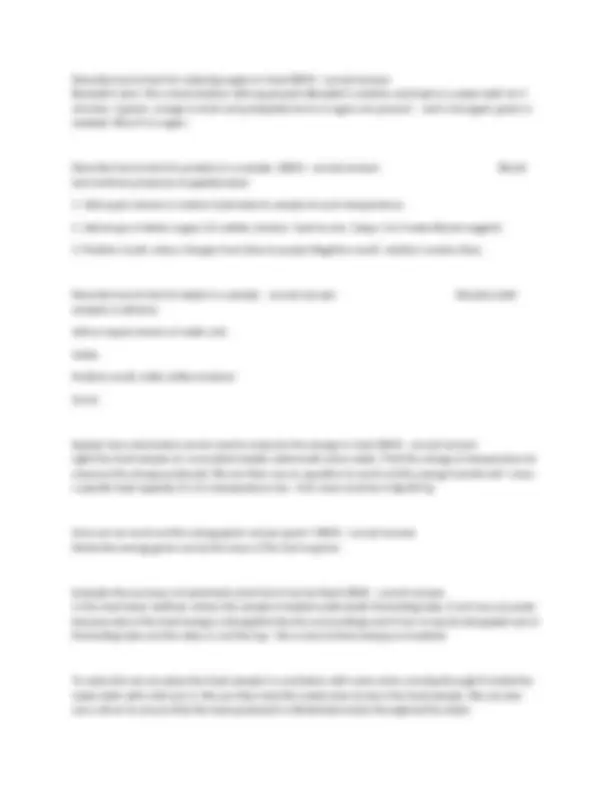






Study with the several resources on Docsity

Earn points by helping other students or get them with a premium plan


Prepare for your exams
Study with the several resources on Docsity

Earn points to download
Earn points by helping other students or get them with a premium plan
Community
Ask the community for help and clear up your study doubts
Discover the best universities in your country according to Docsity users
Free resources
Download our free guides on studying techniques, anxiety management strategies, and thesis advice from Docsity tutors
GCSE Edexcel biology SB1 Final Exam Questions And Answers.
Typology: Exams
1 / 8

This page cannot be seen from the preview
Don't miss anything!





What is an electron microscope? (SB1a) - correct answer Microscopes that send beams of electrons through a specimen to build up an image. What is meant by an instrument's resolution? (SB1a) - correct answer The smallest distance between two visible points Why can some cell structures be seen with an electron microscope but not with a light microscope? (SB1a) - correct answer This is because electrons have a smaller wavelength than visible light and so can reveal tiny details in cells that a light microscope would not be able to How do you calculate the magnification of a microscope? (SB1a) - correct answer eyepiece lens x objective lens How do you calculate the size of an object? (SB1a) - correct answer Image size/magnification - make sure everything is in the same units Name all the parts of an animal cell (5) (SB1b) - correct answer Nucleus, cell membrane (the inside wall), cytoplasm, ribosomes, mitochondria Name all the parts of a plant cell (8) (SB1b) - correct answer Nucleus, cytoplasm, cell membrane (inside wall), cell wall (outside wall), mitochondria, ribosomes, chloroplasts, permanent vacuole What structures exist in plant cells but not animal cells (3)? (SB1b) - correct answer Cell wall, chloroplast, vacuole What are the functions of the structures found in both animal and plant cells? (SB1b) - correct answer Nucleus - Controls the activities for the cell and contains DNA
Cytoplasm - Place in the cell in which reactions occur, also holds organelles Cell membrane - controls what enters and leaves the cell Mitochondria - produces energy for the cell through aerobic respiration Ribosomes - site of protein synthesis What are the functions of the structures found in plant cells? (3) (SB1b) - correct answer Cell wall - supports the cell and prevents the cell from bursting when turgid Chloroplast - contains chlorophyll which traps light energy to perform photosynthesis Permanent vacuole - contains cell sap and stores water, also helps to keep the cell firm and rigid how do you estimate sizes using microscope fields of view? (SB1b) - correct answer Find the diameter of the field of view (should be a circle that shows cells or structures inside), then divide the diameter by however many of the desired structure would fit in that diameter. This will give you an estimate of the size of the desired structure. Watch this video - correct answer https://www.youtube.com/watch? v=jBVxo5T-ZQM State why the lowest power magnification is used when first examining a specimen (SB1b) - correct answer To get the biggest field of view to be able to examine the most cells possible When observing onion cells, there may be large, thick circles that make it difficult to observe the cells, give a method to prevent this (SB1b) - correct answer Lower the objective lens more carefully and gently
-Slime coat What kind of cells are bacteria? (SB1d) - correct answer Prokaryotic Explain the functions of the structures inside a bacteria cell (apart from nucleus, ribosomes, cell wall and membrane, and cytoplasm) (SB1d) - correct answer N.B. in Eukaryotic cells cell walls are made from cellulose but in Prokaryotic they are made from a compound called peptidoglycan. Plasmids - Small rings of DNA that code for extra genes to those provided from the chromosomal DNA Chromosomal DNA - Codes for genes and floats in the cytoplasm as prokaryotic cells have no nucleus Flagella - Tails to allow the cells to move Slime coat - for protection Why are bacteria cells described as being prokaryotic? (SB1d) - correct answer Because they have no membrane bound organelles and no nucleus. What does being membrane bound allow for? (SB1d) - correct answer It allows the organelles within a cell to control what enters and leaves the organelle through the use of a semi-permeable membrane What's the difference between prokaryotic and eukaryotic cells? (SB1d) - correct answer Eukaryotic cells contain a nucleus which holds the DNA of the cell and has membrane bound organelles whereas prokaryotic cells have no nucleus which means the chromosomal DNA floats around in the cytoplasm. Prokaryotic cells also have plasmids which are circular rings of DNA that add on to the main chromosomal DNA to code for extra genes as well as a slime coating instead of a cell wall for protection, however, they do have cell walls for support. Describe how to test for starch in food (SB1f) - correct answer Iodine test. Add iodine, the colour changes from yellow-orange to blue-black if starch is present.
Describe how to test for reducing sugars in food (SB1f) - correct answer Benedict's test. Mix a food solution with equal parts Benedict's solution and heat in a water bath for 5 minutes. A green, orange or brick red precipitate forms if sugars are present. - red is strongest, green is weakest. Blue if no sugars Describe how to test for proteins in a sample. (SB1f) - correct answer Biuret test confirms presence of peptide bond
What is the function of the active site? (SB1g) - correct answer The active site is complementary to the substrate so the enzyme is specific to that substrate. The active site holds the two substrate molecules tightly in the right position for bonds to form between them (an enzyme- substrate complex) and form a product molecule. Remember - once the product molecule is formed it can no longer form with the same enzyme because the shape is slightly different to the original substrate Why do enzymes have a particular shape? (SB1g) - correct answer Due to the differences in the sequence in amino acids when folding into a protein, different enzymes have different shapes which are specific to a particular substrate to be able to form an enzyme substrate complex and therefore a product molecule. Explain how enzymes become denatured (SB1g) - correct answer Changes in the pH or temperature can affect the amino acids as they fold up to form the enzyme protein. If it is affected too much then the active site will no longer be the right shape and complementary to the substrate and so no enzyme substrate complex can be formed to get a product. We know the affect of temperature and pH (if not check p20-21), but what is the affect of substrate concentration on enzyme activity? (SB1h) - correct answer The rate of reaction of the enzyme will increase as the substrate concentration increases until it hits a plateau. This is because by this time all the enzyme active sites will already have substrates and so there will be no more enzymes for the surplus substrates to bind with, creating a plateau as this is the maximum rate of reaction the enzymes can work at at this pH and temperature. How do we calculate the rate of enzyme activity from experimental data? (SB1h) - correct answer See p20. Divide the amount of product (g) formed by the time it took (min) to find the mean rate of reaction for that time (g/min). Watch this video - with all these core practical videos try blurting after watching to remember the method. You can use the core practicals in the book to check they are right. - correct answer https://www.youtube.com/watch?v=JyXXoevEWc How are substances transported? (SB1i) - correct answer Active transport, diffusion and osmosis Describe how substances are transported through active transport (SB1i) - correct answer Active transport is the movement of particles against the concentration gradient (against is high to low
so active transport is low to high) across a partially permeable membrane through the use of energy. The particles are trapped by transporter proteins in the membrane which uses energy to carry the particles across the membrane. Explain the process of diffusion (SB1i) - correct answer Molecules move from an area of higher concentration to an area of lower concentration (down the concentration gradient). N.B. it is a net movement as particles are moving in random directions but overall will move down the concentration gradient. This does not require energy and cannot pass through a membrane. N.B. the steeper the concentration gradient, the quicker diffusion occurs. Explain the process of osmosis (SB1i) - correct answer Water molecules can move across a partially permeable membrane whereas some other particles can't. The water is moved along the concentration gradient by osmosis. This means it moves from a high concentration (where there is lots of water so the solution must be more dilute) to a low concentration (where there is less water and so technically this would be of higher concentration). This movement carries on until the concentration is the same on both sides of the membrane What is the effect of osmosis on cells and tissues? (SB1i) - correct answer It can cause a cell or tissue to gain mass from it gaining water or lose mass from it losing mass. The percentage change in mass can be calculated through change in mass/original x 100. Describe how you could investigate osmosis in potatoes (SB1i) - correct answer